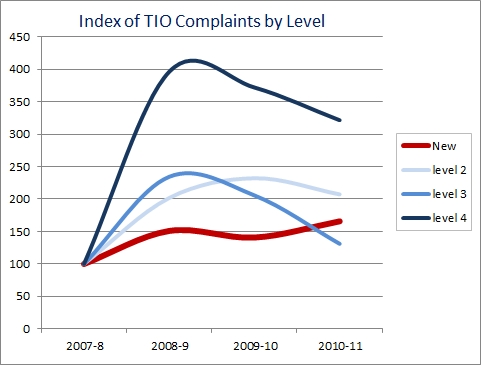By the numbers: taking advantage of the TIO?

There's no doubt that the telco industry needs to lift its game, but is the TIO seeing more complaints simply because more people know about the ombudsman?
This month, the TIO's annual report highlighted a 17 per cent rise in complaints to the ombudsman. "Normally, a chairman would be delighted to report on growth in an annual review. But growth in complaints to the TIO is not something to celebrate," said Andrew Dyer, the TIO's council chair.
But might the complaints be the result of a greater awareness of the TIO? According to Google Trends, that nifty little tool that lets you track search terms, searches for the word "ombudsman" have increased by 50 per cent over the last five years, and the rise in news references has risen even more.

(Credit: Phil Dobbie, compiled from TIO data)
Compare that to searches for "sex", for example, which have fallen a good 20 per cent over the same time period, and you can see that we're all too busy hanging on the phone complaining about our telco to be interested in that sort of thing anymore.
The argument that more people are complaining to the TIO because more of us know about it is supported by the decline in higher-level complaints. Whilst new inquiries rose a whopping 9 per cent last year, investigations beyond the first level fell by 14 per cent. In other words, more people were complaining, but more than ever they were being resolved at the first stage. This would seem to indicate that telcos are using the channel almost as a default frontline complaint-handling service.
Perhaps the most interesting aspect of this situation is with how out of kilter Australia is with the rest of the world. Ofcom in the UK claims to receive (PDF) about 350 telecom complaints per day — 128,000 a year. That's one third less than here (197,682), for a population three times ours.
The divide is even greater when we look to the US: in Q4 of 2010, the FCC received 43,600 complaints. Spread over a year that means a country with 13 times our population receives 10 per cent fewer telco complaints.
It's clear that there's an issue. The imbalance could be because, with Australia's smaller population, telcos are finding it uneconomic to create bigger frontline call centres and more efficient to pay the TIO to filter out the serious complaints. If that's the case, the solution is simple: the TIO should push up fees until it becomes cheaper for telcos to hire more call centre staff. The answer could be a sliding scale, where the more complaints a company has, the more they pay. That would make for an interesting line on the CFO's P&L spreadsheet. I suspect that the TIO complaint numbers would quickly sort themselves out.
Download the TIO annual report here (PDF).